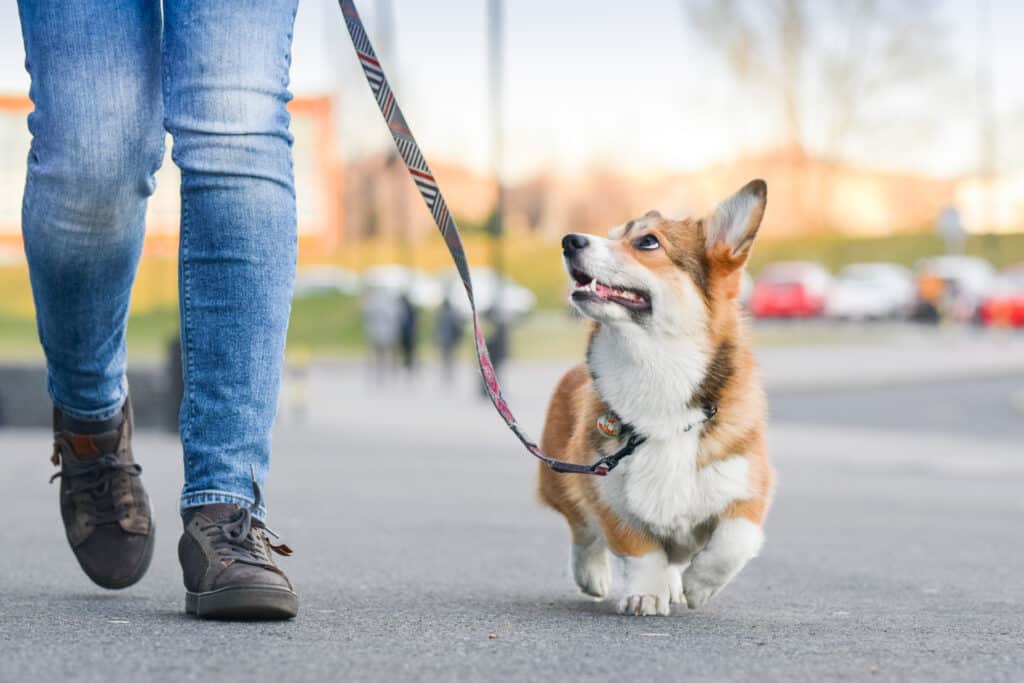There are many reasons people consider invisible fencing for their dogs. The thought usually comes from good intentions, but punishment-based training tools such as electric fences can severely harm your dog and your relationship with them.
You should avoid purchasing an invisible fence for your dog because they aren’t completely reliable and make dogs afraid to come home if they do get out. They also promote fear, aggression, and reactivity. Force-free training methods are the humane way to teach your dog new skills, such as staying in the yard.
In this article, we’ll discuss 13 reasons to avoid buying an invisible fence for your dog, as well as some alternatives.
#1: Invisible Fencing Works by Hurting Your Dog

Invisible fencing harms a dog both physically and mentally.
©Parilov/Shutterstock.com
Please don’t believe anyone saying that invisible fencing won’t hurt your dog. In recent years, I’ve noticed a rebranding in regard to how shock collars and similar items are presented. Companies and trainers will lie about the products and even call them by more polite names to make them seem less cruel.
The truth is, invisible fencing wouldn’t work if it didn’t hurt your dog. The prongs on the collar deliver a shock when they approach the boundary, which typically makes them move away.
The pain has to be strong enough to act as an aversive measure even when your dog is high on adrenaline and really wants to chase something out of the yard.
While there are sometimes warnings in place, such as a sound or vibration to alert the dog they’re too close, your dog isn’t going to learn what these mean without being hurt by the shock at least once. The reason they respond to these cues is fear of injury.
#2: Dogs with Invisible Fencing Feel Constant Fear
As discussed above, your dog only avoids the invisible fence line if they’re afraid of it and the pain it represents. Even if the invisible fence works perfectly, it’s a stressful experience for a dog to go through, and one they experience every day.
This fear can cause behavioral issues like avoiding the yard or even peeing inside the house. It can cause reactivity and aggression toward strangers or family. We’ll discuss more about the behavioral challenges you might see below.
#3: In the Beginning, the Dog is Punished Without Misbehaving

Dogs often become more fearful when an invisible fence is used.
©Cheryl Ann Studio/Shutterstock.com
There is no way for a dog to learn the barriers without being punished for simply wandering around the yard, not yet knowing the boundaries. This is not only physically painful but confusing and emotionally distressing.
Some trainers will charge high fees to train your dog so that they learn the boundaries. However, I would be incredibly wary of a trainer who is willing to do so. They’re likely to also use other training methods that are aversive and punishment-based instead of up-to-date, humane training methods.
Dog training is an unregulated field. Anyone can call themselves a trainer, even if they don’t know anything about dogs and their behavior.
The money you spend on invisible fencing and training could be better spent on traditional fencing or a fear-free trainer. They can help you learn how to teach recall and keep your dog in the yard in other ways.
#4: Dogs May be Confused as to Why They’re Shocked
Some dogs may learn the boundaries on their own after some trial and error. Others may become confused and not understand what’s causing the shocks. This is especially likely in the beginning.
They might also associate the shocks with other things, such as barking at passersby. This can cause reactivity as they begin to associate anyone walking nearby with being punished.
#5: Punishment-Based Training Promotes Fear and Aggression

Invisible fencing can cause or worsen reactivity.
©alexei_tm/Shutterstock.com
Electric fencing and other punishment-based training methods promote fear and aggression. Your dog may become anxious about going outside at all, or they might learn to fear the shock collar since they know it causes pain.
They may become aggressive when you go to let them outside, put the collar on, or even spend time with them in the yard.
These are all reasonable reactions from a dog that doesn’t know what’s going on, just that they’re being hurt. It can severely damage your relationship.
#6: Your Dog is Likely to Become Reactive
Reactivity goes alongside fear and aggression. Your dog may learn to fear strange people or animals walking down the sidewalk because they’re hurt every time when they try to run to greet them.
What was once an exciting occurrence can become distressing, and these negative associations may transfer to meeting new people or dogs on walks, at the dog park, or in other situations.
If your dog is already reactive, electric fencing may make it worse.
#7: Electric Fencing Doesn’t Keep Others Out of Your Yard

Other animals and people can still walk into your yard easily.
©iStock.com/likedat
Invisible fences keep your dog inside (if you’re lucky) but don’t keep other people or animals out. This means that children, dogs, and other animals can freely run into your yard while your dog is outside.
Supervising your dog outdoors can help you to interfere immediately if something goes wrong. But, if you’re outside with your dog anyway, why not consider letting them run on a long leash or training a reliable recall cue?
#8: Others Don’t Know Your Dog is Contained
Passing people or dogs may become frightened by your dog. They won’t necessarily know they’re contained and may think they’re going to charge toward them.
This can cause them to react fearfully or aggressively, and your dog may respond in kind. This escalation of emotions can also cause your dog to ignore the shock and run past the fencing barrier, which we’ll discuss further below.
Well-intentioned people might also walk into the yard assuming your dog is loose, either trying to check their collar for tags or to knock on your door.
#9: If the System Fails, Your Dog Can Escape

Invisible fencing is not fail-proof, and dogs can still run away.
©Ammit Jack/Shutterstock.com
If the fencing system breaks, the battery on your dog’s collar runs out, or any other technical errors occur, your dog can run out of the yard.
Some dogs will learn the boundaries and continue to respect them even without the fencing. Others may continue to test the boundaries until a situation like this occurs, then escape at the first opportunity.
#10: Some Dogs Will Run Through the Fence Despite the Pain
In addition, some dogs are motivated enough by outside forces that they’ll ignore the pain and cross the boundary anyway.
This makes the fencing useless when you most need it, which is when your dog is high-energy and wants to run off.
#11: If Your Dog Gets Out, They’re Unlikely to Return Home

Once loose, your dog is less likely to return home since they’re afraid of being shocked by the fencing.
©Anastasiia Cherniavskaia/Shutterstock.com
Once your dog is out of the yard, they’re much less likely to return home. After all, who opts into a painful experience if they can help it?
This is why experts recommend against punishing your dog for running away. They see it as punishment for coming home, not for leaving. Unfortunately, even if you will react well when your dog returns, they know that the fencing system will not.
#12: The Prongs Can Seriously Injure Your Dog’s Skin
Your dog is unlikely to become seriously injured through short use, but their risk goes up if you keep the shock collar on them long-term. The prongs can irritate or even injure the skin, which can also lead to infections.
#13: Force-Free Training Methods are More Humane

There are several alternatives to invisible fencing that are more effective.
©Jus_Ol/Shutterstock.com
The crux of the issue is that we have much more humane ways to train dogs. We never have to hurt them to get the desired behavior.
I highly recommend looking into fear-free training, also known as relationship-based or science-based training. It’s the most up-to-date, humane training method out there.
Some examples of fear-free training to keep your dog in the yard include:
- Recall training: Train your dog to come when called, using treats or other rewards to reinforce the behavior. Though it takes time and effort, many dogs can learn a reliable recall that allows them to be safely off-leash in the yard. (Never unattended!)
- Redirect door-dashing: If your dog darts toward the door and sprints outside, first implement boundaries to stop this behavior, such as baby gates. Work on teaching them to sit at the door and wait for a release cue before going outside, or teach a “place” cue where they learn to sit somewhere away from the door while it’s opened.
#14: There are Alternatives to Electric Fencing

Use a leash to keep your dog out for potty breaks.
©art nick/Shutterstock.com
Aside from training, there are also other alternatives to electric fencing. The most obvious of these is traditional fencing, but it may be out of budget or not allowed in your neighborhood.
Other methods to consider include:
- Leashing your dog. Dogs should be supervised when using invisible fencing anyway, so clipping a leash onto their collar only takes an extra second. You can take your dog out for quick potty breaks if you’re busy or bring them out on a long line so that they can run around the yard.
- Find a nearby enclosed space for running. My neighborhood has an often-empty dog park, though I wouldn’t recommend crowded parks due to their associated risks. You may also look for Sniff Spots in your area.
- Hands-on exercise. If you’re worried about your dog getting their energy out, it’s important to know that letting them out on their own isn’t usually enough! Many dogs won’t exert that much energy outside on their own but need a buddy to play with. Hands-on play, walks, and other activities with you are much more effective.
At the end of the day, many alternatives to invisible fencing take work on your part. But so does using invisible fencing. It requires training and is unreliable, so your dog will need to be supervised in the yard at all times. On top of this, it hurts your dog.
Adopting a pet means putting in the effort to care for and train them properly. Seemingly quick fixes like invisible fencing often don’t work or cause more problems than they solve.
Thank you for reading! If you have feedback on this post, please contact the AZ Animals editorial team.
The photo featured at the top of this post is © Parilov/Shutterstock.com
Thank you for reading! Have some feedback for us? Contact the AZ Animals editorial team.







